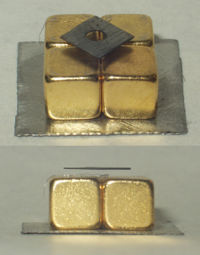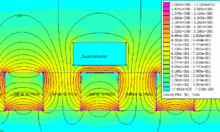- Diamagnetism
-
Diamagnetism is the property of an object which causes it to create a magnetic field in opposition to an externally applied magnetic field, thus causing a repulsive effect. Specifically, an external magnetic field alters the orbital velocity of electrons around their nuclei, thus changing the magnetic dipole moment. According to Lenz's law, these electrons will oppose the magnetic field changes provided by the applied field, preventing them from building up. The result is that lines of magnetic flux curve away from the material. In most materials, diamagnetism is a weak effect, but under conditions of superconductivity, which only some materials may obtain, a strong quantum effect can emerge wherein the lines are completely blocked, excluding a very thin layer at the material's surface. Diamagnets are materials with a magnetic permeability less than μ0 (a relative permeability less than 1).
Contents
History
In 1778, Sebald Justinus Brugmans was the first individual to observe that bismuth and antimony were repelled by magnetic fields. However, the term diamagnetism was coined by Michael Faraday in September 1845, when he realized that all materials in nature possessed some form of diamagnetic response to an applied magnetic field.
Diamagnetic materials
Notable diamagnetic materials[1] Material χv (10−5) Superconductor −105 Pyrolytic carbon −40.0 Bismuth −16.6 Mercury −2.9 Silver −2.6 Carbon (diamond) −2.1 Lead −1.8 Carbon (graphite) −1.6 Copper −1.0 Water −0.91 Diamagnetism is a very general phenomenon, because all electrons, including the electrons of an atom, will always make a weak contribution to the material's response. However, for materials that show some other form of magnetism (such as ferromagnetism or paramagnetism), the diamagnetism is completely overpowered. Substances that mostly display diamagnetic behaviour are termed diamagnetic materials, or diamagnets. Materials that are said to be diamagnetic are those that are usually considered by non-physicists to be non-magnetic, and include water, wood, most organic compounds such as petroleum and some plastics, and many metals including copper, particularly the heavy ones with many core electrons, such as mercury, gold and bismuth. The magnetic susceptibility of various molecular fragments are called Pascal's constants.
Diamagnetic materials have a relative magnetic permeability that is less than or equal to 1, and therefore a magnetic susceptibility which is less than 0 since susceptibility is defined as χv = μv − 1. This means that diamagnetic materials are repelled by magnetic fields. However, since diamagnetism is such a weak property its effects are not observable in everyday life. For example, the magnetic susceptibility of diamagnets such as water is χv = −9.05×10−6. The most strongly diamagnetic material is bismuth, χv = −1.66×10−4, although pyrolytic carbon may have a susceptibility of χv = −4.00×10−4 in one plane. Nevertheless, these values are orders of magnitudes smaller than the magnetism exhibited by paramagnets and ferromagnets. Note that because χv is derived from the ratio of the internal magnetic field to the applied field, it is a dimensionless value.
Superconductors may be considered to be perfect diamagnets (χv = −1), since they expel all fields (except in a thin surface layer) due to the Meissner effect. However this effect is not due to eddy currents, as in ordinary diamagnetic materials (see the article on superconductivity).
Additionally, all conductors exhibit an effective diamagnetism when they experience a changing magnetic field. The Lorentz force on electrons causes them to circulate around forming eddy currents. The eddy currents then produce an induced magnetic field which opposes the applied field, resisting the conductor's motion.
Demonstrations of diamagnetism
Curving water surfaces
If a powerful magnet (such as a supermagnet) is covered with a layer of water (that is thin compared to the diameter of the magnet) then the field of the magnet significantly repels the water. This causes a slight dimple in the water's surface that may be seen by its reflection.[2][3]
Diamagnetic levitation
Diamagnets may be levitated in stable equilibrium in a magnetic field, with no power consumption. Earnshaw's theorem seems to preclude the possibility of static magnetic levitation. However, Earnshaw's theorem only applies to objects with positive moments, such as ferromagnets (which have a permanent positive moment) and paramagnets (which induce a positive moment). These are attracted to field maxima, which do not exist in free space. Diamagnets (which induce a negative moment) are attracted to field minima, and there can be a field minimum in free space.
A thin slice of pyrolytic graphite, which is an unusually strong diamagnetic material, can be stably floated in a magnetic field, such as that from rare earth permanent magnets. This can be done with all components at room temperature, making a visually effective demonstration of diamagnetism.
The Radboud University Nijmegen, the Netherlands, has conducted experiments where water and other substances were successfully levitated. Most spectacularly, a live frog (see figure) was levitated.[5]
In September 2009, NASA's Jet Propulsion Laboratory in Pasadena, California announced they had successfully levitated mice using a superconducting magnet,[6] an important step forward since mice are closer biologically to humans than frogs.[7] They hope to perform experiments regarding the effects of microgravity on bone and muscle mass.
Recent experiments studying the growth of protein crystals has led to a technique using powerful magnets to allow growth in ways that counteract Earth's gravity.[8]
A simple homemade device for demonstration can be constructed out of bismuth plates and a few permanent magnets that will levitate a permanent magnet.[9]
Theory of diamagnetism
The Bohr–van Leeuwen theorem proves that there cannot be any diamagnetism or paramagnetism in a purely classical system. Yet the classical theory for Langevin diamagnetism gives the same prediction as the quantum theory.[10] The classical theory is given below.
Langevin diamagnetism
The Langevin theory of diamagnetism applies to materials containing atoms with closed shells (see dielectrics). A field with intensity
 , applied to an electron with charge
, applied to an electron with charge  and mass
and mass  , gives rise to Larmor precession with frequency
, gives rise to Larmor precession with frequency  . The number of revolutions per unit time is
. The number of revolutions per unit time is  , so the current for an atom with
, so the current for an atom with  electrons is (in SI units)[10]
electrons is (in SI units)[10]The magnetic moment of a current loop is equal to the current times the area of the loop. Suppose the field is aligned with the
 axis. The average loop area can be given as
axis. The average loop area can be given as  , where
, where  is the mean square distance of the electrons perpendicular to the
is the mean square distance of the electrons perpendicular to the  axis. The magnetic moment is therefore
axis. The magnetic moment is thereforeIf the distribution of charge is spherically symmetric, we can suppose that the distribution of
 coordinates are independent and identically distributed. Then
coordinates are independent and identically distributed. Then  , where
, where  is the mean square distance of the electrons from the nucleus. Therefore
is the mean square distance of the electrons from the nucleus. Therefore  . If N is the number of atoms per unit volume, the diamagnetic susceptibility is
. If N is the number of atoms per unit volume, the diamagnetic susceptibility isDiamagnetism in metals
The Langevin theory does not apply to metals because they have non-localized electrons. The theory for the diamagnetism of a free electron gas is called Landau diamagnetism, and instead considers the weak counter-acting field that forms when their trajectories are curved due to the Lorentz force. Landau diamagnetism, however, should be contrasted with Pauli paramagnetism, an effect associated with the polarization of delocalized electrons' spins.[11]
See also
References
- ^ Nave, Carl L.. "Magnetic Properties of Solids". Hyper Physics. http://hyperphysics.phy-astr.gsu.edu/Hbase/tables/magprop.html.
- ^ Beatty, Bill (2005). "Neodymium supermagnets: Some demonstrations—Diamagnetic water". Science Hobbyist. http://amasci.com/amateur/neodymium.html#water. Retrieved September 2011.
- ^ Quit007 (2011). "Magnetic Force". DeviantART. http://quit007.deviantart.com/gallery/23787987#/d2e4dmz. Retrieved September 2011.
- ^ "The Frog That Learned to Fly". High Field Laboratory. Radboud University Nijmegen. 2011. http://www.ru.nl/hfml/research/levitation/diamagnetic/. Retrieved September 2011.
- ^ "The Real Levitation". High Field Laboratory. Radboud University Nijmegen. 2011. http://www.ru.nl/hfml/research/levitation/diamagnetic/. Retrieved September 2011.
- ^ Liu, Yuanming; Zhu, Da-Ming; Strayer, Donald M.; Israelsson, Ulf E. (2010). "Magnetic levitation of large water droplets and mice". Advances in Space Research 45 (1): 208–213. Bibcode 2010AdSpR..45..208L. doi:10.1016/j.asr.2009.08.033.
- ^ Choi, Charles Q. (09-09-2009). "Mice levitated in lab". Live Science. http://www.livescience.com/animals/090909-mouse-levitation.html. Retrieved September 2011.
- ^ Kleiner, Kurt (08-10-2007). "Magnetic gravity trick grows perfect crystals". New Scientist. http://www.newscientist.com/article/dn12467-magnetic-gravity-trick-grows-perfect-crystals.html. Retrieved September 2011.
- ^ "Fun with diamagnetic levitation". ForceField. 02-12-2008. http://web.archive.org/web/20080212011654/http://www.fieldlines.com/other/diamag1.html. Retrieved September 2011.
- ^ a b Kittel, Charles (1986). Introduction to Solid State Physics (6th ed.). John Wiley & Sons. pp. 299–302. ISBN 0-471-87474-4.
- ^ Chang, M. C.. "Diamagnetism and paramagnetism". NTNU lecture notes. http://phy.ntnu.edu.tw/~changmc/Teach/SS/SS_note/chap11.pdf. Retrieved 2011-02-24.
External links
- Video of a museum-style magnetic elevation train model which makes use of diamagnetism
- Videos of frogs and other diamagnets levitated in a strong magnetic field
- Video of levitating pyrolytic graphite
- Video of Meissner-Ochsenfeld effect involving liquid nitrogen
- Video of a piece of neodymium magnet levitating between blocks of bismuth.
Categories:- Electric and magnetic fields in matter
- Levitation
- Magnetism
Wikimedia Foundation. 2010.






